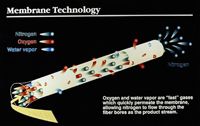Generating Make-Up Gas for GC with an In-House Nitrogen Generator
Since the gas flow required for the separation step in gas chromatography is frequently lower that that required to optimize the detection, nitrogen is used as a make-up gas to increase the gas flow for detection.
Since the gas flow required for the separation step in gas chromatography is frequently lower that that required to optimize the detection, nitrogen is used as a make-up gas to increase the gas flow for detection. In many facilities, zero-grade nitrogen make-up gas is provided from a cylinder or tank. While this approach works, an in-house "make-up" gas generator can provide the desired nitrogen with a higher level of purity than bottled nitrogen. In addition, the use of an in-house make-up gas generator can provide a considerably safer, more convenient, and less expensive approach to supply the required gas.
Design of an In-House Nitrogen Generator
Zero-grade nitrogen for make-up gas can be readily obtained from laboratory compressed air using an in-house generator (Parker Hannifin FID MakeUpGas Generator) that includes a heated catalytic converter in which a proprietary catalyst blend is combined with Platinum to remove all hydrocarbons by converting them to CO2 and water vapor. The convertor is followed by a hollow fiber membrane separator which preferentially allows oxygen and water vapor to quickly permeate the membrane wall while nitrogen travels through the hollow fiber out the end (Figure 1). The hollow fiber has a small internal diameter and thousands of fibers are bundled together to provide a large surface area to provide the desired flow of nitrogen. The makeup gas generator can provide nitrogen with purity of better than 99.9999% with respect to hydrocarbons (<1 ppm) and greater than 99% with respect to oxygen.

Figure 1: Membrane separation technology.
Performance
A chromatographic comparison of the nitrogen that was produced by the MakeUpGas generator and gas that was obtained from bottled fuel air from a commercial supplier is shown in Figure 2. The gas generated by the MakeUpGas generator is much purer than that from bottled fuel air; and provides an extremely flat baseline with essentially no signal due to hydrocarbons, while the zero-grade bottled air provided an irregular baseline with a significant level of hydrocarbons, which could impact the analysis.

Figure 2: Chromatograms comparing baselines produced by a Parker MakeUpGas Generator and bottled fuel air.
Conclusions
In addition to the extremely high level of purity provided by the generator, the use of an in-house generator provides benefits in safety, cost, and convenience. When a MakeUpGas generator is employed, only a small amount of nitrogen is generated at a given instant and a leak would lead to a negligible change in the composition of the laboratory air. In contrast, a leak from a full tank could cause problems. When an in-house generator is employed, gas is available on a 24/7 basis and the possibility of injury or damage during the transportation and installation of a heavy gas tank which can become a guided missile if the valve on a full tank is compromised during transport is eliminated. In addition to the significant safety and convenience benefits, there is an economic benefit from using a MakeUpGas generator. The running cost of operation maintenance of the MakeupGas generator is extremely low; as the raw materials to prepare the required gas are air and electricity.
Parker Hannifin Corporation
Filtration and Separation Division
260 Neck Rd., Haverhill, MA 01835
tel. (800) 343-4048, (978) 858-0505
Website: www.labgasgenerators.com

The Benefits of Custom Bonded Silica
April 1st 2025Not all chromatography resins are created equal. Off-the-shelf chromatography resins might not always meet the rigorous purification requirements of biopharmaceutical manufacturing. Custom bonded silica from Grace can address a wide range of separation challenges, leading to real performance improvements. Discover more about the latest innovations in chromatography silica from Grace, including VYDAC® and DAVISIL®.
5 Things to Consider When Selecting a Chromatography Silica
April 1st 2025Particularly in the pharmaceutical industry, drug purity isn’t just a goal – it’s essential for achieving safety, stability and efficacy. However, purification is easier said than done, especially with challenging molecules like DNA and RNA “oligonucleotides,” due in large part to their diversity and the range of impurities that can be generated during production. Enter DAVISIL® chromatographic silica, with a wide range of pore diameters and particle sizes to meet your specific application, performance and sustainability requirements. Before you choose the chromatography resin for your next purification application, take a look at these 5 considerations.
Automating Protein Purification: Efficiency, Yield, and Reproducibility
March 27th 2025Recent advancements in automated protein purification stress the importance of efficiency, scalability, and yield consistency. This eBook compares different purification platforms, highlighting their impact on downstream applications and demonstrating how automation enhances throughput and process control.
MilliporeSigma: Ultrapure Water for Sensitive LC-MS Analysis of Pesticides
March 25th 2025The aim of the study was to illustrate the efficiency of Milli-Q® water purification systems in eliminating pesticides from tap water, thereby producing and delivering reliable and consistent-quality ultrapure water suitable for pesticides analysis















